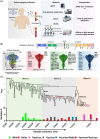Omicron infection increases IgG binding to spike protein of predecessor variants
- PMID: 36546401
- PMCID: PMC9880675
- DOI: 10.1002/jmv.28419
Omicron infection increases IgG binding to spike protein of predecessor variants
Abstract
Severe acute respiratory syndrome coronavirus 2 (SARS-CoV-2) transmission in India in 2020-2022 was driven predominantly by Wild (Wuhan-Hu-1 and D614G), Delta, and Omicron variants. The aim of this study was to examine the effect of infections on the humoral immune response and cross-reactivity to spike proteins of Wuhan-Hu-1, Delta, C.1.2., and Omicron. Residual archival sera (N = 81) received between January 2020 and March 2022 were included. Infection status was inferred by a positive SARS-CoV-2 RT-PCR and/or serology (anti-N and anti-S antibodies) and sequencing of contemporaneous samples (N = 18) to infer lineage. We estimated the levels and cross-reactivity of infection-induced sera including Wild, Delta, Omicron as well as vaccine breakthrough infections (Delta and Omicron). We found an approximately two-fold increase in spike-specific IgG antibody binding in post-Omicron infection compared with the pre-Omicron period, whilst the change in pre- and post-Delta infections were similar. Further investigation of Omicron-specific humoral responses revealed primary Omicron infection as an inducer of cross-reactive antibodies against predecessor variants, in spite of the weaker degree of humoral response compared to Wuhan-Hu-1 and Delta infection. Intriguingly, Omicron vaccine-breakthrough infections when compared with primary infections, exhibited increased humoral responses against RBD (7.7-fold) and Trimeric S (Trimeric form of spike protein) (34.6-fold) in addition to increased binding of IgGs towards previously circulating variants (4.2 - 6.5-fold). Despite Delta breakthrough infections showing a higher level of humoral response against RBD (2.9-fold) and Trimeric S (5.7-fold) compared to primary Delta sera, a demonstrably reduced binding (36%-49%) was observed to Omicron spike protein. Omicron vaccine breakthrough infection results in increased intensity of humoral response and wider breadth of IgG binding to spike proteins of antigenically-distinct, predecessor variants.
Keywords: Breakthrough infection; Delta; Humoral immunity; Immune responses; Omicron; SARS coronavirus; SARS-CoV-2 spike variants.
© 2022 Wiley Periodicals LLC.
Conflict of interest statement
The authors declare no conflict of interest.
Figures





References
-
- WHO Coronavirus (COVID‐19) Dashboard, India . 2022. https://covid19.who.int/region/searo/country/in
Publication types
MeSH terms
Substances
Supplementary concepts
LinkOut - more resources
Full Text Sources
Medical
Miscellaneous

